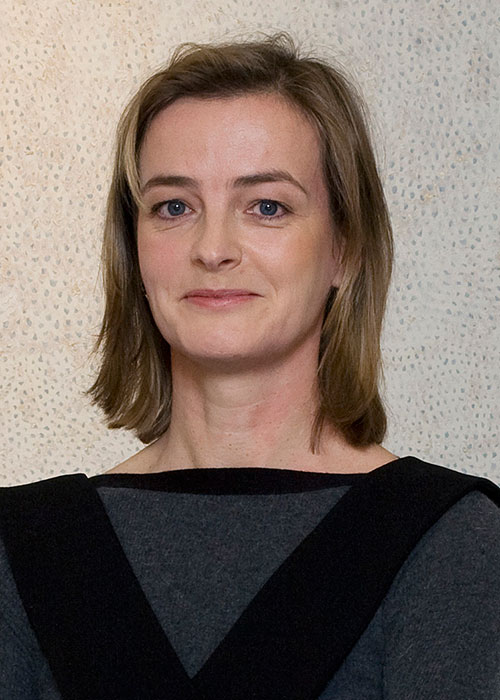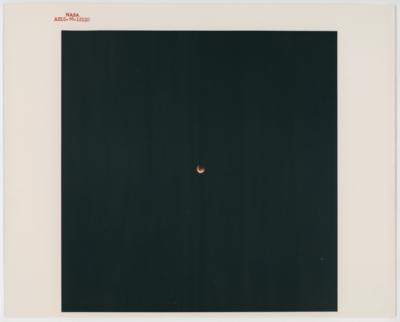David Scott (Apollo 15)
The extraordinary first lunar eclipse observed by humans from deep space, 26 July - 7 August 1971
Vintage chromogenic print on fiber-based paper, printed 1971, numbered "NASA AS15-96-13120" (NASA MSC) in red in top margin, with "A KODAK PAPER" watermark on verso, 20,3 x 25,4 cm
[original NASA caption for a variant of the photograph] …The lunar eclipse was recorded in a series of color photographs. Even when the Moon was not in eclipse during this series, it was in Earth's penumbra - the partially shadowed region where only a part of the sun's light can reach the moon directly. The white region, whenever it appears, is penumbral lighting of the lunar surface. The orange-red-brown band is caused by sunlight that has first passed through Earth's atmosphere where the shorter wavelength, blue light has been scattered out, allowing only a diminished intensity red light to reach the moon. These pictures tell us something about Earth's atmosphere with the lunar surface acting as a projection screen where we can examine the results….
From the mission transcript when the series of eclipse photographs were taken:
269:22:04 Irwin: Houston, 15. The Moon's in the shadow now and we have a variation in color from a almost a light gray to a burnt orange from one side of the Moon to the other. Almost like the old harvest Moon, except that I'm not sure there's any atmosphere up here yet.
269:22:23 Henize: Roger. We copy.
Comm break.
269:25:17 Irwin: Houston, 15. We've finished the photos, and Al had the Moon in the reflex part of the Nikon all the way, so I'm sure the pointing was okay.
269:25:25 Henize: Very good.
269:25:26 Irwin: Right now the Moon is sort of - varies from sort of a very pale orange to a good deep burnt orange on one side and a very gradual change. And I hope the - the photos come out because it - it certainly is pretty.
269:25:45 Henize: Very good. It sounds like a beautiful view from up there. You've seen a lunar eclipse of the Moon twice as big as anyone else has ever seen such an eclipse. [...]
cockpit lights down reasonably low and get our face up in the window can we see the definition. So it's really not a bad picture.
Esperta: Mag. Eva Königseder
 Mag. Eva Königseder
Mag. Eva Königseder
+43-1-515 60-421
eva.koenigseder@dorotheum.at
27.09.2023 - 17:16
- Prezzo realizzato: **
-
EUR 975,-
- Stima:
-
EUR 800,- a EUR 1.200,-
- Prezzo di partenza:
-
EUR 100,-
David Scott (Apollo 15)
The extraordinary first lunar eclipse observed by humans from deep space, 26 July - 7 August 1971
Vintage chromogenic print on fiber-based paper, printed 1971, numbered "NASA AS15-96-13120" (NASA MSC) in red in top margin, with "A KODAK PAPER" watermark on verso, 20,3 x 25,4 cm
[original NASA caption for a variant of the photograph] …The lunar eclipse was recorded in a series of color photographs. Even when the Moon was not in eclipse during this series, it was in Earth's penumbra - the partially shadowed region where only a part of the sun's light can reach the moon directly. The white region, whenever it appears, is penumbral lighting of the lunar surface. The orange-red-brown band is caused by sunlight that has first passed through Earth's atmosphere where the shorter wavelength, blue light has been scattered out, allowing only a diminished intensity red light to reach the moon. These pictures tell us something about Earth's atmosphere with the lunar surface acting as a projection screen where we can examine the results….
From the mission transcript when the series of eclipse photographs were taken:
269:22:04 Irwin: Houston, 15. The Moon's in the shadow now and we have a variation in color from a almost a light gray to a burnt orange from one side of the Moon to the other. Almost like the old harvest Moon, except that I'm not sure there's any atmosphere up here yet.
269:22:23 Henize: Roger. We copy.
Comm break.
269:25:17 Irwin: Houston, 15. We've finished the photos, and Al had the Moon in the reflex part of the Nikon all the way, so I'm sure the pointing was okay.
269:25:25 Henize: Very good.
269:25:26 Irwin: Right now the Moon is sort of - varies from sort of a very pale orange to a good deep burnt orange on one side and a very gradual change. And I hope the - the photos come out because it - it certainly is pretty.
269:25:45 Henize: Very good. It sounds like a beautiful view from up there. You've seen a lunar eclipse of the Moon twice as big as anyone else has ever seen such an eclipse. [...]
cockpit lights down reasonably low and get our face up in the window can we see the definition. So it's really not a bad picture.
Esperta: Mag. Eva Königseder
 Mag. Eva Königseder
Mag. Eva Königseder
+43-1-515 60-421
eva.koenigseder@dorotheum.at
|
Hotline dell'acquirente
lun-ven: 10.00 - 17.00
kundendienst@dorotheum.at +43 1 515 60 200 |
| Asta: | The Beauty of Space - Iconic Photographs of Early NASA Missions |
| Tipo d'asta: | Asta online |
| Data: | 27.09.2023 - 17:16 |
| Luogo dell'asta: | Wien | Palais Dorotheum |
| Esposizione: | Online |
** Prezzo d'acquisto comprensivo di tassa di vendita e IVA
Non è più possibile effettuare un ordine di acquisto su Internet. L'asta è in preparazione o è già stata eseguita.

